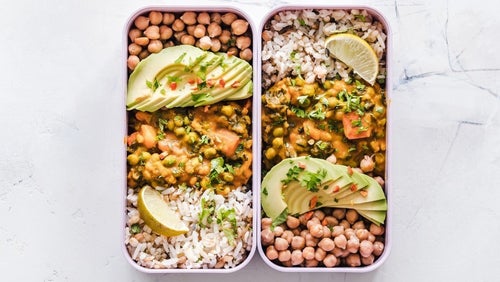
There's one thing that all successful weight loss diets have in common: calorie deficit. If you want to lose weight sustainably, then it's crucial you understand the concept.
So, let’s take a closer look at what calories are, what factors determine your energy requirements, and how to calculate the all-important calorie deficit.
- What Are Calories?
- What Are the Average Calorie Requirements for an Adult?
- What is a Calorie Deficit?
How to Calculate a Calorie Deficit - How to Create a Calorie Deficit
- What Foods Are Good for a Calorie Deficit?
- How to Maintain a Healthy Lifestyle in a Calorie Deficit
- Supplements to Support Your Calorie Deficit
- Calorie Deficit FAQs
What Are Calories?
Specifically, one calorie is the amount of energy required to raise the temperature of one gram of water by one degree Celsius.
But to most people, calories are the way we measure the energy we get from food. While it's common to hear about calories in terms of the amount burned through exercise, in fact, all things we do, from breathing to thinking to digesting food, require energy and therefore “burn” calories.
What Are the Average Calorie Requirements for an Adult?
According to the NHS, the recommended daily calorie intake is between 2,000 and 2,500.1 However, there are many things that can impact your daily energy requirements. Everyone is different, and understanding the factors that affect your body’s needs is key to creating a successful plan.
Factors that affect your calorie intake
Physical activity: The more you move, the more energy you need. This is mostly affected by exercise, but the little things you do, like walking to work or having an active job, can have a considerable impact. Illness: When recovering from illness, infection, or injury, the body requires more energy than usual. So it’s important to eat well when this is the case. Medical conditions: Certain diseases and medical conditions can increase a person’s daily energy requirements.2 Body composition: Muscle requires more energy than body fat, so those who have more lean muscle mass usually have higher calorie requirements.3,4 Gender: Men typically have higher calorie needs than women, usually due to having more muscle mass, lower body fat, and greater height. Environmental factors: Temperature can impact BMR as the body has to work harder to maintain its normal temperature, eg sweating in hot weather. Hormones: Fluctuations in hormones can influence energy expenditure. For example, various studies have found that during the luteal phase of the menstrual cycle, women can experience up to a 20% increase in their metabolic rate due to the increase in progesterone.5-7
What is a Calorie Deficit?
A calorie deficit is when you consistently consume fewer calories than your body expends. For example, if your body requires around 2,000 calories per day but you consistently consume around 1,700 calories per day, you will be in a calorie deficit. This is the only way to lose body fat over time.
How is a calorie deficit important for weight loss?
The one thing all weight loss diets have in common is a calorie deficit. Whether it’s by consuming more protein or less carbs or fat, it’s the consistent reduction in overall calorie intake that leads to a reduction in body fat. If you want to lose weight, creating a deficit is essential.
How much of a calorie deficit do I need for weight loss?
A daily deficit of around 400-1,000 calories per day is recommended for sustainable weight loss of between 0.5-1kg (about 1-2 lb) per week. But remember that every person’s calorie requirements vary depending on lifestyle and environmental factors. Also, be wary of setting unrealistic targets, as this can lead to a lack of adherence.
How to Calculate a Calorie Deficit
1. Calculate your daily maintenance calorie intake
The most accurate way of measuring a person’s energy requirements is through a technique known as direct calorimetry, which measures the rate of heat loss using a calorimeter.8 However, this method is rarely used due to its complexity and cost. Instead, there are plenty of equations that can calculate approximately how much energy the body needs. The Harris-Benedict equation is probably the most popular, but the best is the Mifflin-St Jeor equation below.9
Men: BMR = 10 x weight (kg) + 6.25 x height (cm) - 5 x age (years) + 5 Women: BMR = 10 x weight (kg) + 6.25 x height (cm) - 5 x age (years) - 161
This equation calculates your approximate Basal Metabolic Rate, or BMR, which is the number of calories that your body requires at complete rest. So, if you were to lay in bed all day, this is the amount of energy that your body would still require to carry out basic functions.
Calculating your TDEE
Your Total Daily Energy Expenditure (TDEE) is your maintenance calories and is worked out by calculating your BMR plus any energy required for physical movement. This includes intentional exercise, but also the activity you do day-to-day, known as Non-Exercise Activity Thermogenesis (NEAT).
To calculate your TDEE, you simply multiply your BMR by a physical activity level (PAL) factor. PAL values should account for both your exercise and NEAT activity. The figure you get is your daily energy requirements to maintain your current body weight.
PAL values
Sedentary (little to no exercise): 1.2 Lightly active (light exercise or sports 1-3 days a week): 1.375 Moderately active (moderate exercise or sports 3-5 days a week): 1.55 Very active (hard exercise or sports 6-7 days a week): 1.725 Super active (very hard exercise and a physical job or training twice a day): 1.9
2. Adjust your calorie intake for weight loss
Once you know your body’s daily energy needs, you can calculate the number of calories needed for weight loss. It’s better to aim for a realistic calorie reduction with a goal of 0.5-1kg of weight loss per week.10 If you’re unsure, start with a smaller deficit and adjust as needed.

5 High-Protein Muscle-Building Breakfast Recipes
There’s nothing like the thought of waffles to get you out of bed in the morning...
3. Consider your physical activity
Calorie deficits can come from a combination of both consuming less energy and using more energy. If you already have a balanced diet and aren’t sure where to reduce calories, you might have to increase your movement to support a calorie deficit. If you know you can reduce your portions and cut your intake of high-calorie foods, you can focus on a greater calorie deficit from your diet.
Calculating exactly how many calories you use during exercise is tricky, because it is not an exact science and will be influenced by various factors. The best way to estimate calorie burn is with a device that measures your heart rate and adjusts for your age, weight, and activity level.
How to Create a Calorie Deficit
1. Focus on realistic changes
If you’re already eating a healthy diet made up of plenty of lean protein, fresh vegetables, and whole grains, it might not be the best option to reduce your calorie intake too much. Instead, you could create a deficit by increasing your activity levels. This doesn’t need to be an extra gym session, but could be getting off the train or bus a stop earlier to walk further, adding cardio to your regular gym session, or taking the dog for more daily walks.
On the flip side, if you are already pushing yourself for 2 hours a day at the gym but don’t pay too much attention to your diet, it might be time to consider whether your diet is holding you back.
2. Don't go too low
It can be tempting to go straight in for a higher calorie deficit with the aim of faster weight loss. However, extremely low-calorie intakes or major deficits that result in quick weight loss are rarely sustainable. Plus, if your calorie consumption is too low over time, your body will adjust and your BMR becomes lower, which makes it harder to lose weight. Aiming for 0.5-1kg of weight loss per week has been shown to be the most sustainable and the most likely to be maintained in the long term.10
3. Change it up ... but not too much
If you’re sticking to your diet but your workouts aren’t getting you where you want to be, make sure you’re still pushing yourself. Continually tweaking your exercise routine is needed to keep progressing. Just try to avoid making constant adjustments to your calories. What you do consistently will help you to achieve goals, so focus on consistency over time rather than daily perfection.
What Foods Are Good for a Calorie Deficit?
No single food or food group is best or worst when it comes to weight loss. Mostly, it comes down to energy balance. But this doesn’t mean you should just eat whatever you like as long as you’re below your maintenance calories. Protein is particularly important when trying to lose weight, as it’s needed to maintain muscle mass. Additionally, try to eat as many vegetables, fruits, fibrous carbohydrates, and healthy fats as you can.
None of this means you should eat food you don’t enjoy. The “best” diet is one you can stick to long term. Feeling restricted or constantly hungry is likely to backfire and result in the diet being unsuccessful.

What is Dietary Fibre? | 23 High Fibre Foods
Good news: Popcorn made the list....
How to Maintain a Healthy Lifestyle in a Calorie Deficit
Incorporate cardio and strength training
Cardio gives the most efficient calorie burn in a daily workout, but lifting weights is what can really change your body over time. Building mass by building muscle actually increases your BMR and burns more calories on a daily basis in the long term. Strength training is doubly important during a calorie deficit because it will help you maintain your muscle mass while supporting fat loss.
Sleep more, stress less
Stress, both mental and physical, can dramatically affect your performance goals, which can cause even further stress. The body responds to stress through a cascade of events. Cortisol is a steroid hormone normally released in response to “stressful” events, such as exercise, injury, and other high-pressure situations. Cortisol carries many metabolic effects, and elevated cortisol is thought to stall weight loss and even promote weight gain, usually through fluid retention. Focusing on sleep quality and quantity can also support a reduction of stress in the body, so ensure you get plenty of it.
Changes to your diet in a calorie deficit
Increase your fibre intake
Fibre helps to keep us feeling full for longer, so fibre-rich foods like fruits, vegetables, pulses, legumes, and complex carbohydrates are valuable when in a calorie deficit.
Keep your protein intake high
Protein is crucial for muscle repair and growth, but it’s especially important during periods of weight loss as it helps to maintain muscle mass. Plus, like fibre, protein is also highly satiating.

14 Foods Surprisingly High In Protein
The underdogs of the protein world have entered the chat......
Stay hydrated
Staying hydrated is important for optimal focus, performance, and health. Water is the best choice and contains no calories. Juices, fizzy drinks, and other sweet beverages can be high in calories. This doesn’t make them “bad", but cutting them out can make a big contribution to a calorie deficit.
Consume less "added sugar" foods and drinks
When in a calorie deficit, you may become more aware of the calories and nutrients in certain foods. Some food products may contain high amounts of added sugar, which can add up over the course of a day and week. Think about the sugar or syrups you may add to your morning tea or coffee, or fizzy drinks that you consume regularly, and consider if you can replace these with lower-sugar variations. Of course, it’s what you do regularly that counts. Enjoying a sweet drink every now and then is not going to make or break your weight-loss plan.
Supplements to Support Your Calorie Deficit
Staying in a calorie deficit can be challenging, but the right supplements can make it easier to manage your intake, get the nutrients you need, and stay on track with your goals. Here are a couple of great options from Myprotein.
Clear Whey Isolate
Clear Whey Isolate is a great option for maintaining a calorie deficit because it provides a solid 20g of protein at under 90 calories a shake. Made with fast-absorbing hydrolyzed whey protein isolate, Clear Whey fuels muscles fast and supports their growth.
Clear Whey is a light, refreshing protein shake that comes in a variety of vibrant, fruity flavors. Our formula contains 4g of BCAAs and 3g of glutamine—amino acids that support muscle growth and energy levels. With no sugar or fat, Clear Whey provides only the essentials to help support your weight loss journey.
Impact Whey Isolate
Impact Whey Isolate is another solid option for supporting your weight loss goals. Each serving delivers up to 25g of protein, helping you feel full and supporting muscle maintenance while on a low-carb, low-fat diet.
In addition to its high protein content, Impact Whey Isolate is under 100 calories per serving and contains no fat or added sugar. Available in a variety of delicious flavors, our super pure protein makes it easy and enjoyable to increase your daily protein intake without adding unnecessary calories. It's also a great option for vegetarians and is gluten free.
Calorie Deficit FAQs
Can I eat takeout while on a calorie deficit?
You don't have to eliminate any specific foods to be in a calorie deficit. However, many takeout meals are energy-dense, which can make it harder to stay within your calorie goal. You can still enjoy takeout, just be mindful of your portion size and consider choosing leaner or lower-fat options to make it easier to stay on track.
Can I build muscle and lose fat at the same time?
Building muscle and losing fat simultaneously is often referred to as "body recomposition". While it's a challenging process, it is possible. To gain muscle, a calorie surplus is generally recommended, whereas fat loss requires a deficit. However, by prioritizing a high protein intake and consistent strength training while in a moderate calorie deficit, you can encourage your body to burn fat for energy while preserving and even building a small amount of muscle mass.11
How does a calorie deficit work for vegetarians?
The principle of a calorie deficit remains the same for vegetarians as for any other dietary pattern. However, for vegetarians, it's crucial to ensure adequate protein intake to support muscle maintenance and feelings of fullness. If you find it challenging to consume enough protein, a more conservative calorie deficit may be a better option to minimize potential muscle loss.
Why am I not losing weight in a calorie deficit?
While the "calories in, calories out" model is the foundation of weight loss, factors like stress, sleep, and hormonal changes can all impact your results. If you are consistently in a deficit but not seeing progress, consider your lifestyle habits and consult a registered dietitian or nutritionist for personalized advice.
Take Home Message
While calculating a calorie deficit is based on relatively simple science, the truth is, we’re not robots, and in reality, it’s rarely as straightforward.
Take a close look at your lifestyle, habits, and schedule, and decide what sustainable changes you can make to cut your calorie intake over an extended period of time.
If you’re prepared to accept that your goal may take some time to reach, you’ll be more likely to make the lasting changes needed to get there.
Enjoyed this article?

Ultimate Nutrition Guide for Bodybuilders | Maximize Muscle Growth
It’s about more than just upping calorie intake......

Complete Guide to Pre-Workout: Ingredients, Timing, & Dosage
Take your training to the next level with our guide to pre-workout....
READ THESE NEXT:

- NHS. 2023. Understanding calories. Retrieved from: https://www.nhs.uk/live-well/healthy-weight/managing-your-weight/understanding-calories/
- Patel, D., Shan, A., Mathews, S., & Sathe, M. (2022). Understanding Cystic Fibrosis Comorbidities and Their Impact on Nutritional Management. Nutrients, 14(5), 1028. https://doi.org/10.3390/nu14051028
- Stehno-Bittel, Lisa. “Intricacies of fat.” Physical therapy 88, no. 11 (2008): 1265-1278.
- Liaqat, Ayesha, Kiran Fatima Nasir, Nimra Saeed, and Muneeba Javed. “True Facts About Burning Calories.” (2023). Biological Times.
- Howe, J. C., Rumpler, W. V., & Seale, J. L. (1993). Energy expenditure by indirect calorimetry in premenopausal women: variation within one menstrual cycle. The Journal of Nutritional Biochemistry, 4(5), 268-273.
- Benton, M. J., Hutchins, A. M., & Dawes, J. J. (2020). Effect of menstrual cycle on resting metabolism: A systematic review and meta-analysis. PLoS One, 15(7), e0236025
- Draper, C. F., Duisters, K., Weger, B., Chakrabarti, A., Harms, A. C., Brennan, L., … & Van Der Greef, J. (2018). Menstrual cycle rhythmicity: metabolic patterns in healthy women. Scientific reports, 8(1), 1-15.
- Ndahimana, D., & Kim, E. K. (2017). Measurement Methods for Physical Activity and Energy Expenditure: a Review. Clinical nutrition research, 6(2), 68–80. https://doi.org/10.7762/cnr.2017.6.2.68
- Mifflin, M. D., St Jeor, S. T., Hill, L. A., Scott, B. J., Daugherty, S. A., & Koh, Y. O. (1990). A new predictive equation for resting energy expenditure in healthy individuals. The American journal of clinical nutrition, 51(2), 241-247.
- Raynor, H. A., & Champagne, C. M. (2016). Position of the Academy of Nutrition and Dietetics: Interventions for the Treatment of Overweight and Obesity in Adults. Journal of the Academy of Nutrition and Dietetics, 116(1), 129-147.
- Longland, T. M., Oikawa, S. Y., Mitchell, C. J., Devries, M. C., & Phillips, S. M. (2016). Higher compared with lower dietary protein during an energy deficit combined with intense exercise promotes greater lean mass gain and fat mass loss: a randomized trial. The American journal of clinical nutrition, 103(3), 738-746.
















